April 6, 2016, Wednesday — A Religious “Off-Ramp” for Ukraine?
US Ambassador Pyatt Visits Rome

In a visit that has received no press attention up until now, the U.S. ambassador to Ukraine, Geoffrey Pyatt (photo) was in Rome on Monday, April 4, on an unusual one-day visit that included consultations with Vatican officials.
The visit was unusual because it was not announced publicly and because, diplomats say, it is “unusual” for an ambassador to one country (like Ukraine) to make a semi-diplomatic stop in another country (like the Holy See).
This suggests that it was an important visit.
Pyatt held meetings with Vatican officials for about two hours, according to sources I have spoken with.
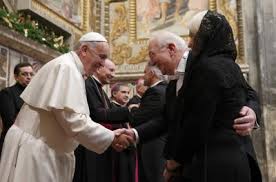
Hackett was chosen by President Barack Obama on June 14, 2013 to serve as the U.S. Ambassador to the Holy See. The U.S. Senate confirmed Ambassador Hackett on August 1, 2013. So his term of office has practically coincided with the pontificate of Pope Francis, which began with his election on March 13, 2013, just over three years ago.
The lunch was at the ambassador’s residence on the top of the Janiculum hill.
Several officials of the Holy See were present.
These included the rector of the Russicum, the Vatican’s institute for the study of the Russian language and culture, and more than one official from different Holy See offices.
What was the importance of Pyatt’s visit and what was discussed?
First of all, on the face of it, Pyatt’s visit suggests that the unfolding situation of tragic conflict in Ukraine, which remains very high on the agenda of the U.S. government, may be prompting the US to seek closer contacts and collaboration with the Holy See and Pope Francis.
But why, precisely?
First, because the situation of hundreds of thousands of Ukrainian refugees in the east, who have left their homes to seek to avoid being involved in the conflict, may be precipitating into tragedy.
This suggests that the U.S. may wish to have the Vatican’s help to resolve a situation that may be getting out of the control of traditional diplomatic means.
Second, there continue to be troop movements in Ukraine, and signs that the fragile Minsk peace accords may fracture and fail.
In this context, the U.S. may be seeking the Holy See’s help in resolving the Ukraine conflict — which has already claimed thousands of lives, including many children — before it spirals out of control and claims many more.
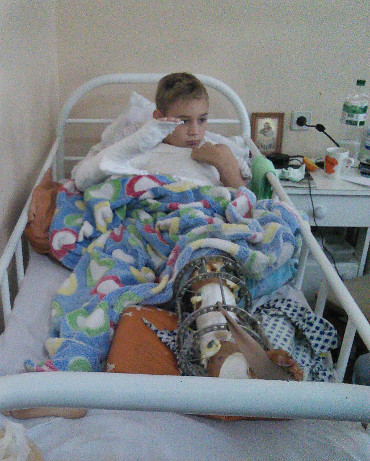
Holy See officials have told me they would like all of these mines to be removed, but that mine-sweeping operations are currently impossible in the present situation of conflict. This means that almost every week there are new, tragic incidents of lost arms and legs, and deaths. Both sides are said to have their own maps of where the land mines are, but nothing is being done to remove them. And so the rich soil of Ukraine is mined with explosives that are killing the country’s children. Pope Francis has been informed of this situation, and is deeply disturbed by it. (link to a story about such injuries) At least 109 children are reported to have been injured and 42 killed by landmines and unexploded ordnance in the Donetsk and Luhansk regions since March 2014. The real number of victims is likely to be higher if including non-government controlled areas, where humanitarian access is limited. link)
Ambassador Pyatt’s discussions with Vatican officials were private.
However, it is clear from prior public statements that the diplomacy of the U.S. wishes the Holy See and Pope Francis to take a sharper position directly critical of Russia’s role in the two-year-old Ukrainian conflict.
The U.S. has several times urged the Vatican publicly to criticize Russia’s involvement in the Ukraine conflict more forcefully.
One such occasion was just hours before Pope Francis was due to meet Russian President Vladimir Putin in June 2015. (link)
A June 10, 2015 Reuters report quoted U.S. Ambassador Hackett in this way: “It does seem that Russia is supporting the insurgents and does seem that there are Russian troops inside Ukraine,” said Ken Hackett, the U.S. ambassador to the Vatican. “Maybe this is an opportunity where the Holy Father can privately raise concerns. Certainly Pope Francis has been told about the situations that are happening in eastern Ukraine… so is he is not unaware.”
But the Holy See has not been persuaded by this invitation.
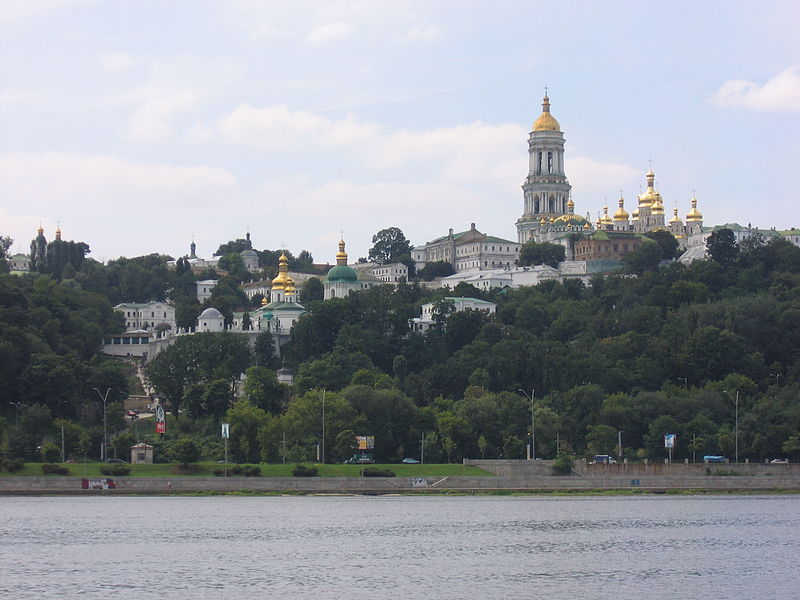
A photo of the Kiev Pechersk Lavra / the Kiev Monastery of the Caves, in Kiev, Ukraine. View from Dnieper river, the river where Prince Vladimir was baptized in the year 988, bringing Christianity to the Russian people. This is the headquarters of the Ukrainian Orthodox Church that is in communion with the Russian Orthodox Patriarchate of Moscow
Pope Francis, for his part, has always referred to the conflict in the Ukraine as a “war between Christians” without criticizing Moscow.
Russian Orthodox Church leaders have praised Pope Francis for this “balanced approach.”
This suggests that what Pope Francis is seeking is, in fact, a “peace between Christians” — that is, a “religious off-ramp” to the Ukraine crisis.
As Reuters reported in that June piece: “Pope Francis, believing his role is to seek the healing of wounds and not to enter into politics by making accusations against any party, has resisted this (U.S.) pressure” (to condemn Russia).
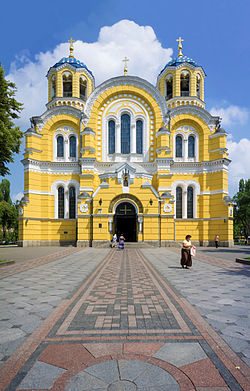
Here, St Volodymyr’s Cathedral in the center of Kiev. It is one of the city’s major landmarks and the mother cathedral of the Ukrainian Orthodox Church – Kiev Patriarchy, one of two major Ukrainian Orthodox Churches — the Church that is separated from Moscow, and not recognized as canonical by international Orthodoxy, but that has won increasing acceptance from the Ukrainian people
So it seems reasonable to suppose that among the reasons that Pyatt was in Rome meeting with Vatican officials was a continuing desire of the U.S. government to have the Vatican more directly condemn what the U.S. has described as Russia’s “aggression” against Ukraine.
This condemnation is what justifies the West’s imposition of economic sanctions on Russia.
But, the Holy See has unswervingly maintained its “line” on the Ukraine situation up to now.
The policy pursued by the Holy See has been to try to remain “super partes” — “above the parties” in the dispute — in order to perhaps become one of the “honest brokers” who seem likely to be needed to resolve this conflict.
Therefore, the Holy See has called repeatedly for a cessation of hostilities, for peace discussions (as in the Minsk negotiations), and for humanitarian aid for those most affected by the hostilities, the people and children of eastern Ukraine.
A final step in this diplomacy would be to seek a meeting with the leaders of all of Ukraine’s Churches to create the needed “religious off-ramp.”
So the Holy See could play a positive role in seeking a just peace in Ukraine.
But what could that role be?
A Religious “Off-Ramp”?
Arguably, a “religious off-ramp” might help resolve a situation in which traditional diplomatic measures are ineffective and perhaps doomed to failure.
A “religious off-ramp” might include having all of the Churches in Ukraine be part of a “Christian coalition” to help resolve a political conflict which seems otherwise too complicated, too deeply rooted in decades-old animosities, to resolve.
Setting aside their quite real and legitimate differences and grievances, the Churches could collaborate to bring peace to Ukraine.
The Role of the Pope’s “Super Envoy,” Archbishop Gugerotti
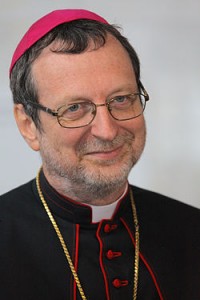
Gugerotti has been in the Vatican diplomatic service since 1985.
I came to know him during the Orthodox-Catholic Forum in Minsk, Belarus, during the first week of June, 2014. (Our Urbi et Orbi Foundation, which I direct, was a co-sponsor of that session of the bi-annual Forum; this was why I was in attendance).
Gugerotti is a scholar of Oriental languages and literatures, an expert on Armenia, and on eastern liturgy, a former professor in the University of Venice, Padua, and Rome — La Sapienza, and also at the Gregorian and Pontifical Oriental Institute in Rome.
His first Vatican post in 1985 was with the Congregation for Eastern Churches under the astute Vatican diplomat, Cardinal Achille Silvestrini.
On December 7, 2001, Pope John Paul II made him an archbishop and appointed him his nuncio in Georgia, Armenia and, on December 13, 2001, also in Azerbaijan.
His episcopal consecration came of January 6, 2002, at the hands of Pope John Paul II, with Archbishops Leonardo Sandri and Robert Sarah as co-consecrators.
On July 15, 2011, he was named nuncio in Belarus. (This is why he was hosting the Orthodox-Catholic Forum in Minsk in 2014. It is also the reason that he had hopes at that time that the meeting between Pope Francis and Patriarch Kirill might occur in June 2014, but it was not to be, and had to wait until Havana, February 12, 2016).
On November 13, 2015, Gugerotti was named nuncio in Ukraine.
And, in early March, Pope Francis asked Gugerotti to make a trip to eastern Ukraine, and then to come to Rome and report to him personally on what he had seen and heard.
Gugerotti made that trip, and came to Rome for a meeting with Pope Francis on the afternoon of March 14.
I was able also to speak with Gugerotti on March 14, and to hear from him the essence of his report.
And that was that there are 600,000 refugees in eastern Ukraine, in “miserable” conditions, including many women and children and old people.
And that was that the land mines in eastern Ukraine are still killing and maiming children every week.
And that was that there needs to be an urgent humanitarian effort — if possible, together with the Orthodox Churches in the country — to help reduce the misery of those hundreds of thousands of people.
This is the context for the Pope’s unexpected, and otherwise unexplained, announcement on April 3 that, in every Catholic parish in Europe, there will be, on April 24, a special collection for the Ukrainian refugees. He called for this because he had just heard Gugerotti’s report.
Speaking to tens of thousands of people at the end of a Mass on Divine Mercy Sunday in St. Peter’s Square (three days ago, April 3), Francis said he wanted the collection to be a “gesture of charity that, apart from alleviating material suffering, shows my personal closeness as well as that of the entire Church” to the people of Ukraine.
The Pope did not say how the aid would be distributed. But clearly, the help of the Orthodox would be useful and welcome.
There are about 120,000 Roman Catholic parishes in Europe, with the largest number, about 27,000, in Italy. If each parish were to collect $1,000, the amount collected would be $120 million.
It is not clear why the Pope did not call for such a collection in the United States and Canada.
Still, in this context, it is interesting to note that Ambassador Hackett, who hosted ambassador Pyatt on Monday for these private talks, was President of Catholic Relief Services (CRS), an international humanitarian agency supported by the US Catholic community, from 1993 to 2012. As CRS President, Hackett led 5,000 CRS employees in over 100 countries.
For this reason, Hackett might be an appropriate person to help organize and carry out an effort to help relief supplies reach the destitute refugees in eastern Ukraine.
Also, yesterday the Osservatore Romano, the Vatican’s daily newspaper, published an article on the need to locate and remove land mines all over the world. (link)
The removal of all land mines in eastern Ukraine would perhaps be an appropriate project for all of the Churches in Ukraine to collaborate on, as they seek to play a role in the building of peace in their very beautiful but now suffering country.
Supplementary Background Information
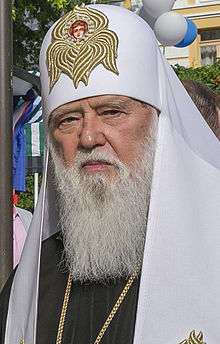
(1) The first is united with Moscow. The head of this Russian Orthodox Church in Ukraine is Metropolitan Onufry.
(2) The second is a non-canonical Church gathered around Patriarch Filaret (secular name in Ukrainian Mykhailo Antonovych Denysenko, in Russian Mikhail Antonovich Denisenko, officially His Holiness, the Patriarch of Kyiv and All Rus’ — Ukraine).
(3) There is a third, independent Ukrainian Orthodox Church is much smaller, and also not recognized canonically by the Orthodox world.
For Moscow, the Orthodox Church is Ukraine is very important. About one-third of all Russian Orthodox bishops are in Ukraine. So the splitting off of millions of Orthodox into a separate Orthodox Church is deeply worrisome to Moscow.
The history of the most important split, between the first two patriarchates, involves personal motives.
Filaret, now 87, was in 1990 a candidate to become head of the Russian Orthodox Church in Moscow, but was passed over.
Upon the death of Patriarch Pimen I on May 3, 1990, Filaret was widely viewed as a front runner in the Russian Orthodox Church patriarchal election, especially when he became a patriarchal locum tenens.
However, on June 6, 1990 the Sobor of the Russian Orthodox Church elected Metropolitan Alexius of Leningrad, who was enthroned as Patriarch Alexius II. (He reigned until 2009, at which time Kirill was elected to replace him.)
In other words, had Filaret been elected, he would have been in the position of Patriarch Kirill today.
Instead, Filaret became the head of the non-canonical Ukrainian Orthodox Church of the Kyivan Patriarchate (since 1995).
He was excommunicated by the Moscow Patriarchate in 1997. (For much more on this history, see the following link.)
Patriarch Filaret currently leads the drive for his Church to become a single Ukrainian national Church, but his attempts to gain a canonical recognition for the Church remain unsuccessful.
In early September 2014, as the conflict in eastern Ukraine intensified, Filaret said that Russian President Vladimir Putin “calls himself a brother to the Ukrainian people, but in fact according to his deeds, he really became the new Cain, shedding the brotherly blood and entangling the whole world with lies” (referring to the bible story in which Cain kills his brother Abel). He went on to conclude about Putin “Satan went into him, as into Judas Iscariot.”
Precise figures on the numbers belonging to these Churches are difficult to know, and the figures below are just from one survey, and may be inaccurate, but they offer a certain general perspective.
According to a May 2014 opinion poll by the Razumkov Center, 70 percent of the 42.5 million Ukrainians (about 32 million people) considered themselves Orthodox faithful.
(Note: Ukraine’s population has been in sharp decline: there were more than 52 million Ukrainians in 1993, just after the break-up of the Soviet Union. So the country has lost over the past 25 years almost 10 million people, about 20% of its population.)
Among those 42 million Ukrainians, the number belonging to the Kyiv Patriarchate Church has increased from 22 percent to 26 percent to 32 percent (about 14 million) over the past three years. This steady increase, of course, worries Moscow.
The share of the Moscow Patriarchate–affiliated Church has slightly decreased from 28 to 25 percent (to about 11 million).
The third, independent Ukrainian Orthodox Church, numbers an estimated five to 10 percent of all Ukrainian Orthodox (or less than an estimated 3 million people). (link)
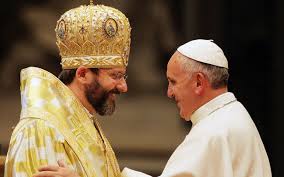
Currently the Church has between 3 to 5 million members in Ukraine.
Numerous surveys conducted since the late 1990s consistently show that between 6% and 8% of Ukraine’s total population, or 9.4% to 12.6% of the country’s religious believers, identify themselves as belonging to this Church.
Worldwide, the Ukrainian Greek Catholic faithful now number some 6 to 10 million, forming the world’s largest particular Catholic Church, after the majority Latin Rite Church.
The demographics of Ukraine show that the Greek Catholic Church is increasing at the expense of the majority Orthodox Church, due to higher birth rates and lower death rates among its members.
According to a 2015 survey, followers of the Ukrainian Greek Catholic Church make up 8.1% of the total population (excluding Crimea) and form the majority in 3 of the country’s most western “oblasts” or districts:
Lviv Oblast — 59% of the population
Ivano-Frankivsk Oblast — 57%
Ternopil Oblast — 52%
The Latin rite Catholic Church is also present in Ukraine, but counts considerably less than 1 million members.
And so we have a sort of “religious” profile of a predominantly Christian Ukraine which is divided into several Orthodox and Catholic Churches, with Catholics being in a majority on the west, and Orthodox being an overwhelming majority in the east of the country.
The roles of Pope Francis, head of the Roman Catholic Church, of Patriarch Kirill, head of the Russian Orthodox Church and its many adherents in Ukraine, of Patriarch Filaret and his non-canonical Orthodox Church, and of Major Archbishop Schevchuk, head of the Greek Catholic Church in communion with Rome, would all be important if there is indeed to be a “religious off-ramp” to heal the impasse in Ukraine.
Perhaps the hope of ending the exploding of mines and maiming of children in the east of the country could be sufficient motivation for the holding of a meeting to begin the process of Ukraine’s reconciliation and just peace.
Special note: We will be traveling to Moscow, Kiev, Istanbul and Rome from July 8 to 18 on our Urbi et Orbi Foundation pilgrimage. This pilgrimage is for members of the Foundation, and involves meetings with leading figures in both the Catholic and Orthodox Churches, in Moscow, Kiev, Istanbul, and Rome. (Among the many meetings and events will be a concert in the Kremlin performed by the world-renowned Italian singer Andrea Bocelli, co-sponsored by the Holy See and the Russian Orthodox Church.) If you would like to join the Foundation and participate in and support our work, or, if you would like more information on this pilgrimage, please email [email protected], and we will send you further information. The pilgrimage is limited to 10 people.
The Urbi et Orbi Foundation: The purpose of the Urbi et Orbi Foundation is to build bridges of trust and understanding to enable the possibility of greater Church unity, without seeking to minimize or overlook the important theological and doctrinal issues that continue to impede this unity. We hope to assist in the implementation of the February 12 common declaration of Havana, Cuba, by Pope Francis and Patriarch Kirill, and in so doing to fulfill the vision of Pope John Paul II of a Church which “breathes with two lungs,” in keeping with the final prayer of Jesus, that those who were his disciples “might all be one” in unity of faith and doctrine.
Note: These newsflashes go to some 20,000 people around the world. If you would like to subscribe, simply send me an email address, and I will add you to the list. Also, if you would like to subscribe to our print magazine, Inside the Vatican, please do so! It would support the old technology of print and paper, as well as this newsflash. Click here.
What is the glory of God?
“The glory of God is man alive; but the life of man is the vision of God.” —St. Irenaeus of Lyons, in the territory of France, in his great work Against All Heresies, written c. 180 A.D.






Facebook Comments